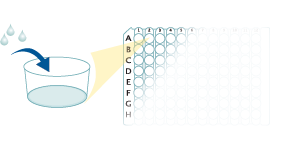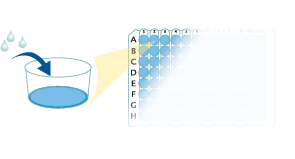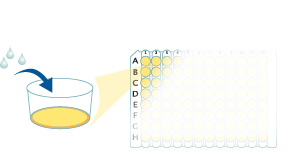Human Endostatin Quantikine ELISA Kit Summary
Product Summary
Precision
Cell Culture Supernates, Serum, EDTA Plasma, Heparin Plasma, Saliva
| Intra-Assay Precision | Inter-Assay Precision | |||||
|---|---|---|---|---|---|---|
| Sample | 1 | 2 | 3 | 1 | 2 | 3 |
| n | 20 | 20 | 20 | 40 | 40 | 40 |
| Mean (pg/mL) | 0.7 | 2.02 | 4.14 | 0.76 | 2.13 | 4.21 |
| Standard Deviation | 0.05 | 0.12 | 0.15 | 0.06 | 0.13 | 0.24 |
| CV% | 6.9 | 6 | 3.6 | 7.9 | 6.1 | 5.7 |
Recovery
The recovery of Endostatin spiked to levels throughout the range of the assay in various matrices was evaluated.
| Sample Type | Average % Recovery | Range % |
|---|---|---|
| Cell Culture Media (n=4) | 101 | 91-114 |
| EDTA Plasma (n=4) | 100 | 92-110 |
| Heparin Plasma (n=4) | 98 | 86-108 |
| Serum (n=4) | 100 | 93-110 |
Linearity
Scientific Data
Product Datasheets
Preparation and Storage
Background: Endostatin
Endostatin is a 20 kDa proteolytic fragment of the C-terminal, non-collagenous (NC1) domain of type XVIII Collagen. It was originally identified as a factor produced by murine hemangioendothelioma cells that could specifically inhibit endothelial cell proliferation and angiogenesis. Although the molecular signals that trigger the release of Endostatin from type XVIII Collagen are not well understood, multiple proteases have been suggested to be involved in its generation including Cathepsins S, B, L, and V, Elastase, and matrix metalloproteinases (MMPs)-2, -7, and -9. Endostatin is of particular interest as it has been shown to inhibit the growth of many primary and metastatic tumors. It may also be involved in down-regulating angiogenesis during physiological processes such as wound healing and the establishment of placental circulation. The anti-angiogenic activity of Endostatin is attributable to its ability to inhibit endothelial cell proliferation and suppress VEGF-and FGF basic-induced endothelial cell migration and adhesion. Many of these effects are thought to be mediated by interactions between Endostatin and endothelial cell-expressed Transglutaminase 2, Heparin, and Integrins alpha 5 beta 1 and alpha V beta 3.
Assay Procedure
Refer to the product- Prepare all reagents, standard dilutions, and samples as directed in the product insert.
- Remove excess microplate strips from the plate frame, return them to the foil pouch containing the desiccant pack, and reseal.
- Add 100 µL of Assay Diluent to each well.
- Add 50 µL of Standard, control, or sample to each well. Cover with a plate sealer, and incubate at room temperature for 2 hours on a horizontal orbital microplate shaker.
- Aspirate each well and wash, repeating the process 3 times for a total of 4 washes.
- Add 200 µL of Conjugate to each well. Cover with a new plate sealer, and incubate at room temperature for 2 hours on the shaker.
- Aspirate and wash 4 times.
- Add 200 µL Substrate Solution to each well. Incubate at room temperature for 30 minutes on the benchtop. PROTECT FROM LIGHT.
- Add 50 µL of Stop Solution to each well. Read at 450 nm within 30 minutes. Set wavelength correction to 540 nm or 570 nm.





Citations for Human Endostatin Quantikine ELISA Kit
R&D Systems personnel manually curate a database that contains references using R&D Systems products. The data collected includes not only links to publications in PubMed, but also provides information about sample types, species, and experimental conditions.
22
Citations: Showing 1 - 10
Filter your results:
Filter by:
-
Circulating pro- and anti-angiogenic factors in multi-stage liver disease and hepatocellular carcinoma progression
Authors: YY Joo, JW Jang, SW Lee, SH Yoo, JH Kwon, SW Nam, SH Bae, JY Choi, SK Yoon
Sci Rep, 2019-06-24;9(1):9137.
Species: Human
Sample Types: Serum
-
Systemic Inflammation Precedes Microalbuminuria in Diabetes
Authors: FG Scurt, J Menne, S Brandt, A Bernhardt, PR Mertens, H Haller, C Chatzikyrk
Kidney Int Rep, 2019-06-21;4(10):1373-1386.
Species: Human
Sample Types: Serum
-
Selectively activated PRP exerts differential effects on tendon stem/progenitor cells and tendon healing
Authors: J Zhang, D Nie, K Williamson, JL Rocha, MV Hogan, JH Wang
J Tissue Eng, 2019-01-16;10(0):2.04173E+15.
Species: Human
Sample Types: Cell Culture Supernates
-
Circulating Vascular Basement Membrane Fragments are Associated with the Diameter of the Abdominal Aorta and Their Expression Pattern is Altered in AAA Tissue
Authors: M Holsti, A Wanhainen, C Lundin, M Björck, G Tegler, J Svensson, M Sund
Eur J Vasc Endovasc Surg, 2018-04-12;0(0):.
Species: Human
Sample Types: Plasma
-
Systemic Sclerosis Sera Impair Angiogenic Performance of Dermal Microvascular Endothelial Cells: Therapeutic Implications of Cyclophosphamide.
Authors: Borghini A, Manetti M, Nacci F, Bellando-Randone S, Guiducci S, Matucci-Cerinic M, Ibba-Manneschi L, Weber E
PLoS ONE, 2015-06-15;10(6):e0130166.
Species: Human
Sample Types: Serum
-
Arterial Hypertension Is Characterized by Imbalance of Pro-Angiogenic versus Anti-Angiogenic Factors.
Authors: Marek-Trzonkowska N, Kwieczynska A, Reiwer-Gostomska M, Kolinski T, Molisz A, Siebert J
PLoS ONE, 2015-05-07;10(5):e0126190.
Species: Human
Sample Types: Serum
-
Treatment of medulloblastoma with oncolytic measles viruses expressing the angiogenesis inhibitors endostatin and angiostatin.
Authors: Hutzen, Brian, Bid, Hemant K, Houghton, Peter J, Pierson, Christop, Powell, Kimerly, Bratasz, Anna, Raffel, Corey, Studebaker, Adam W
BMC Cancer, 2014-03-19;14(0):206.
Species: Human
Sample Types: Cell Culture Supernates
-
Exercise increases serum endostatin levels in female and male patients with diabetes and controls.
Authors: Sponder M, Dangl D, Kampf S, Fritzer-Szekeres M, Strametz-Juranek J
Cardiovasc Diabetol, 2014-01-06;13(0):6.
Species: Human
Sample Types: Serum
-
Anticoagulation inhibits tumor cell-mediated release of platelet angiogenic proteins and diminishes platelet angiogenic response.
Authors: Battinelli, Elisabet, Markens, Beth A, Kulenthirarajan, Rajesh A, Machlus, Kellie R, Flaumenhaft, Robert, Italiano, Joseph E
Blood, 2013-09-24;123(1):101-12.
Species: Human
Sample Types: Whole Cells
-
Inflammation induced by MMP-9 enhances tumor regression of experimental breast cancer.
Authors: Leifler K, Svensson S, Abrahamsson A, Bendrik C, Robertson J, Gauldie J, Olsson A, Dabrosin C
J Immunol, 2013-03-15;190(8):4420-30.
Species: Mouse
Sample Types: Tissue Homogenates
-
Antitumor activities of human placenta-derived mesenchymal stem cells expressing endostatin on ovarian cancer.
Authors: Zheng, Lan, Zhang, Dongmei, Chen, Xianchen, Yang, Li, Wei, Yuquan, Zhao, Xia
PLoS ONE, 2012-07-24;7(7):e39119.
Species: Human
Sample Types: Cell Culture Supernates
-
Prognostic significance of the angiogenic factors angiogenin, endoglin and endostatin in cervical cancer.
Authors: Landt S, Mordelt K, Schwidde I, Barinoff J, Korlach S, Stoblen F, Lichtenegger W, Sehouli J, Kummel S
Anticancer Res., 2011-08-01;31(8):2651-5.
Species: Human
Sample Types: Serum
-
In vitro vascular tube formation testing as a tool for treatment individualisation in patients with cervical cancer.
Authors: Landt S, Heidecke H, Korlach S, Reuter C, Schwidde I, Barinoff J, Thill M, Sehouli J, Kummel S
Anticancer Res., 2011-08-01;31(8):2609-15.
Species: Human
Sample Types: Serum
-
Non-viral endostatin plasmid transfection of mesenchymal stem cells via collagen scaffolds.
Authors: Sun XD, Jeng L, Bolliet C, Olsen BR, Spector M
Biomaterials, 2008-12-06;30(6):1222-31.
Species: Goat
Sample Types: Cell Culture Supernates
-
Expression pattern and circulating levels of endostatin in patients with pancreas cancer.
Authors: Ohlund D, Ardnor B, Oman M, Naredi P, Sund M
Int. J. Cancer, 2008-06-15;122(12):2805-10.
Species: Human
Sample Types: Plasma
-
Tamoxifen and aromatase inhibitors differentially affect vascular endothelial growth factor and endostatin levels in women with breast cancer.
Authors: Holmes CE, Huang JC, Pace TR, Howard AB, Muss HB
Clin. Cancer Res., 2008-05-15;14(10):3070-6.
Species: Human
Sample Types: Plasma
-
Suppression of renal cell carcinoma growth and metastasis with sustained antiangiogenic gene therapy.
Authors: Mellon MJ, Bae KH, Steding CE, Jimenez JA, Kao C, Gardner TA
Hum. Gene Ther., 2008-05-01;19(5):487-95.
Species: Human
Sample Types: Serum
-
Gene transfer of matrix metalloproteinase-9 induces tumor regression of breast cancer in vivo.
Authors: Bendrik C, Robertson J, Gauldie J, Dabrosin C
Cancer Res., 2008-05-01;68(9):3405-12.
Species: Human
Sample Types: Tissue Homogenates
-
Pharmacokinetic and pharmacodynamic study of intratumoral injection of an adenovirus encoding endostatin in patients with advanced tumors.
Authors: Li HL, Li S, Shao JY, Lin XB, Cao Y, Jiang WQ, Liu RY, Zhao P, Zhu XF, Zeng MS, Guan ZZ, Huang W
Gene Ther., 2007-12-20;15(4):247-56.
Species: Human
Sample Types: Serum
-
Over-expression of p53 mutants in LNCaP cells alters tumor growth and angiogenesis in vivo.
Authors: Perryman LA, Blair JM, Kingsley EA, Szymanska B, Ow KT, Wen VW, MacKenzie KL, Vermeulen PB, Jackson P, Russell PJ
Biochem. Biophys. Res. Commun., 2006-05-11;345(3):1207-14.
Species: Human
Sample Types: Cell Culture Supernates
-
Celecoxib up-regulates the expression of the zeta chain of T cell receptor complex in tumor-infiltrating lymphocytes in human cervical cancer.
Authors: Ferrandina G, Ranelletti FO, Legge F, Salutari V, Martinelli E, Fattorossi A, Lorusso D, Zannoni G, Vellone V, Paglia A, Scambia G
Clin. Cancer Res., 2006-04-01;12(7):2055-60.
Species: Human
Sample Types: Serum
-
Circulating endothelial cells and angiogenic serum factors during neoadjuvant chemotherapy of primary breast cancer.
Authors: Furstenberger G, von Moos R, Lucas R, Thurlimann B, Senn HJ, Hamacher J, Boneberg EM
Br. J. Cancer, 2006-02-27;94(4):524-31.
Species: Human
Sample Types: Serum
FAQs
No product specific FAQs exist for this product, however you may
View all ELISA FAQsReviews for Human Endostatin Quantikine ELISA Kit
There are currently no reviews for this product. Be the first to review Human Endostatin Quantikine ELISA Kit and earn rewards!
Have you used Human Endostatin Quantikine ELISA Kit?
Submit a review and receive an Amazon gift card.
$25/€18/£15/$25CAN/¥75 Yuan/¥2500 Yen for a review with an image
$10/€7/£6/$10 CAD/¥70 Yuan/¥1110 Yen for a review without an image




